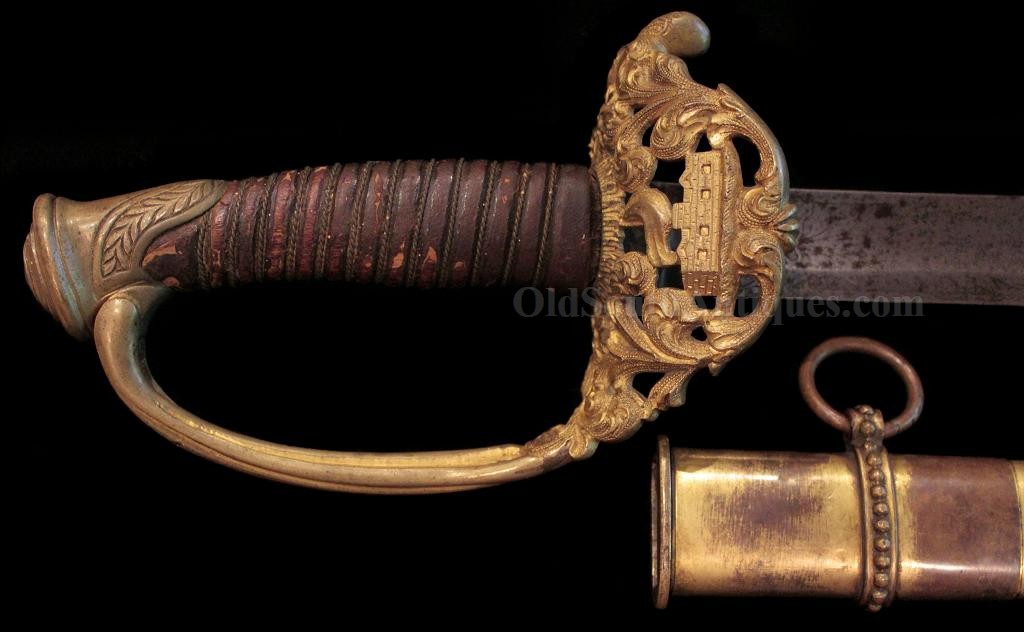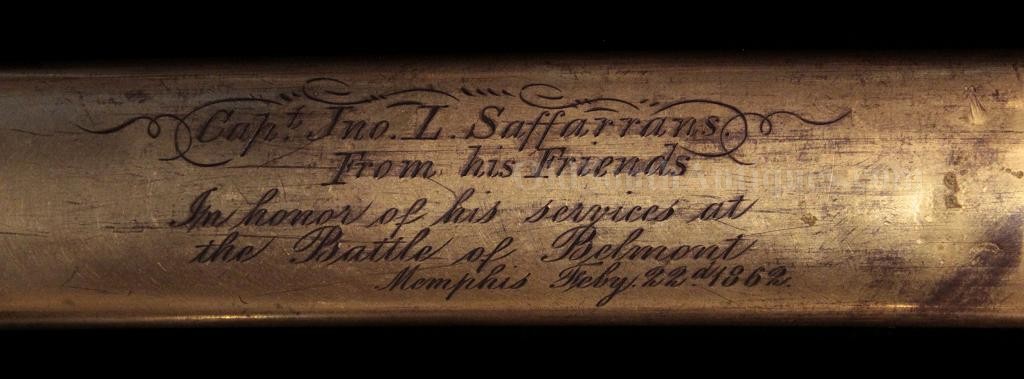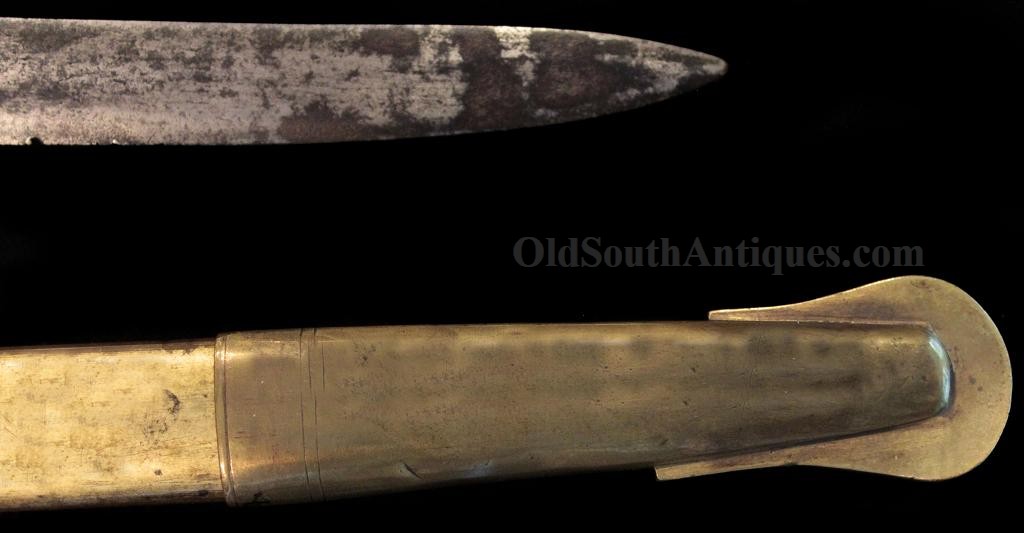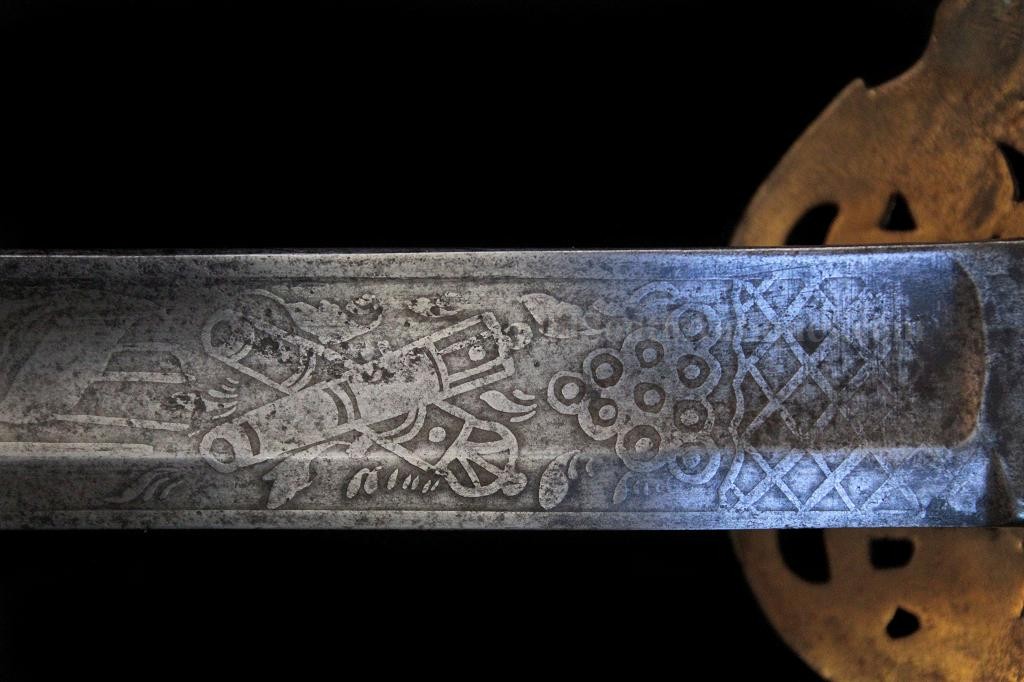
| Catalog | Past Items | Order Info | Terms/Conditions | About Us | Inventory Clearance |
The scabbard of the elaborate sword shown here has a presentation engraved in its gilt brass scabbard, that reads: "Capt Jno L. Saffarrans. From his Friends In honor of his services at the Battle of Belmont/ Memphis Feby 22nd 1862” The Battle of Belmont, a Southern victory, was fought November 7th, 1861 at Belmont, Missouri.
Thomas, Griswold & Company swords are found with several different company markings and with no markings at all. This is true for both the company’s artillery and cavalry officer’s swords. The company manufactured swords to sell at retail on the New Orleans market and wholesale to retailers such as Hayden & Whilden of Charleston, South Carolina. The latter were stamped with Hayden and Whilden’s name and address. It is also known that Thomas, Griswold & Company made swords for the Confederate and various Southern state governments.
Thomas, Griswold & Co. has long been recognized to have manufactured some of the very finest swords of the Confederate era. This was due to their pre-war experience as Hyde & Goodrich, military manufacturers and importers New Orleans, Louisiana. Hyde & Goodrich was started in 1853 and in August of 1861 it became Thomas, Griswold & Co. the new principles being Henry Thomas, Jr., A. B. Griswold, A. L. Abbott and Henry Ginder, the last two only rating an "& Co.” in the company’s moniker.
There are several notable characteristics of the company’s products; the first is that the blade is highly unusual for a Confederate made sword. It has a stopped fuller as a result of the manufacturers having acquired the necessary equipment and skills in the pre-war years. Another notable feature is the high quality scabbard made entirely of brass from throat to drag. Both of these characteristics are commonly found on their "production” swords. This workmanship displayed in this beautiful Fort Hilt goes far beyond their standard quality work.
The sword of course gets its name from the masonry fort cast into the counterguard. We do not know for sure what fort was used as a model or if it was a generic fort, but it is generally assumed it is to be representative of Fort Sumter. This pattern is so rare that even the renowned William Albaugh during the many years of searching out and photographing swords for his several books on Confederate edged weapons never had the opportunity to photograph even a single example. So rare is it in fact, it is not pictured in Collecting the Confederacy, The Commanders Series, American Swords and Makers Marks, American Swords and Sword Makers, all of which are highly sword focused. The closest I could find was a similar sword in Echoes of Glory.
This is considered by many to be the holy grail of sword collecting; it is the one sword that virtually all Confederate sword collectors want, but only a very, very few ever achieve. Not only is this the most desirable of swords, it is a higher grade than others of this pattern; having a gilt plating on the entire sword and beaded scabbard. The mounts are ornately decorated with beading. It is perfect; it does not have a single dent from throat to washer.
The leather wrap is original, and though well worn, it is in beautiful condition. The twisted wire wrap is original and remains tight. The guard has slight play. The blade is beautifully decorated with a prominent script CS, a Confederate First National Flag, and crossed cannon. The ricasso is marked T,G & Co. N.O. The remainder of the blade is profusely etched flower and vine patterns. It is in excellent condition; its only flaws are minor carbon staining and a slight bit of pitting and couple of nicks near the point.
So beautiful is
this sword it transcends the world of Confederate arms collecting and enters
into the realm of art. However, the
really important part is the sword’s presentation to one of the Confederacy’s gallant
sons. John Larkin Saffarrans was a
wealthy Memphis merchant and founder located at 13 Main Street in 1855. When the War came, though forty one years old
and exempt from service, Saffarrons enlisted as Captain of Company I, 2nd Tennessee
Volunteers on May 1st, 1861.
On the morning of 7th November 1861, the men of the 2nd
Tennessee Volunteer Infantry were camped around the town of Columbus, Kentucky,
on the east bank of the Mississippi. They were watching the battle developing in
the camp across the river at Belmont, Missouri. Ulysses S. Grant was based up river in Cairo,
Illinois, and had decided to launch an amphibious operation down the river at
Belmont, Missouri. In what was their
first major fight of the war, Ulysses S. Grant’s
regiments quickly began driving the surprised Confederates at Belmont out of
their camp and towards the Mississippi.
As disaster loomed, Brigadier-General Benjamin F. Cheatham ordered the 2nd Tennessee Regiment, which was on the opposite side of the river from Belmont, to board steamers to be ferried across to the fight. They were greeted on the Missouri shore by chaotic scenes as they landed. Men crowded the river bank as they sought escape from the Union advance, which had smashed the Confederate line and swept across Camp Johnston. Total defeat appeared only minutes away, and large numbers of men were in imminent danger of capture. In the desperate situation, the 2nd Tennessee needed little incentive to fight. They had been told before they crossed the river that sick men from the 12th Tennessee, which contained a number of their friends, had been bayoneted where they lay as the Union troops overran the camp. (wounded were burnt alive in their tents)
Their attack was fierce, the Yanks were not expecting a serious counterattack, but the when the 2ndcharged into them, the collision stopped the enemy’s advance, and Grant’s shaken men never recovered. Lieutenant James Walker, took over command of Company I when Captain Saffarrans fell wounded in the face. [1] The Second Regiment had given the retreating Confederates time to get themselves together and return to the fray and eventually Grant and his minions were driven to their boats, Grant himself making a narrow escape. (too bad) Saffarrans wound was so severe that the Memphis Argus reported that the Captain had been killed. For his actions that day, Captain John L. Saffarrans was presented an exquisite Thomas, Griswold & Co. sword by his unnamed friends on February 22nd, 1862.
Though I cannot find it in his official records, it is written that the Captain was again wounded at the Battle of Shiloh. Too old and too feeble for field command after his recovery, he spent the remainder of the War in the Quartermaster’s Department.
At the Centennial Exposition held in Philadelphia
in 1876, among the many relics displayed was "sword-scabbard of Captain John L.
Saffarrans” Note that only the scabbard was displayed, even at that early date
the sword and scabbard had become separated. Sometime after 1979, the sword and scabbard were united or possibly
reunited since both are so extremely rare, fit so well, and the gilt wear
matches so well. The brass drag has been
replaced, (seemingly, long ago) otherwise the sword and scabbard are completely
original and in beautiful condition.
This sword could be the centerpiece of any collection or the centerpiece of any room and will instantly become a historical heirloom to be treasured for generations. $65,000.00
Copyright © 2025 OldSouthAntiques.com All Rights Reserved.
Privacy Policy | Terms of Use
Powered by Web-Cat Copyright © 1996-2025 GrayCat Systems











